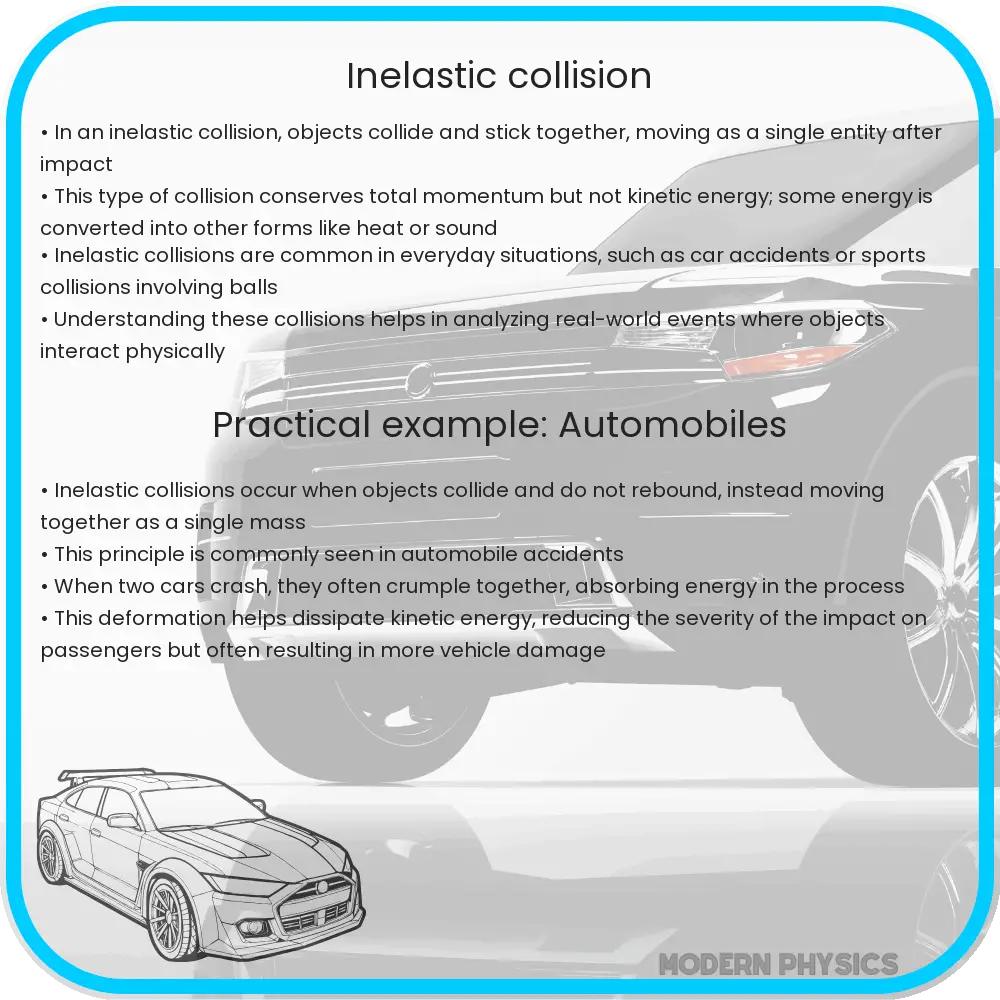Explore the dynamics of inelastic collisions, their impact on momentum and energy loss, and applications in safety and particle physics.

Inelastic Collision: Understanding Momentum and Energy Loss
In the realm of physics, an inelastic collision is a type of collision where the kinetic energy is not conserved due to the action of internal forces. It’s a fundamental concept, particularly in the study of momentum and energy transfer.
Overview of Momentum in Inelastic Collisions
The principle of conservation of momentum states that the total momentum of a closed system remains constant if it is not acted upon by external forces. In an inelastic collision, while the kinetic energy is not conserved, the momentum is. This is expressed in the equation:
pinitial = pfinal
Here, p represents momentum, which is the product of mass (m) and velocity (v). In an inelastic collision, the colliding objects may stick together or deform, leading to a shared final velocity.
Energy Loss in Inelastic Collisions
In inelastic collisions, the loss of kinetic energy is often transformed into other forms of energy, such as heat, sound, or potential energy (in the form of deformation). The kinetic energy after the collision is less than it was before the collision. The difference in kinetic energy can be calculated using the formula:
ΔKE = KEinitial – KEfinal
Where KEinitial is the total kinetic energy before the collision, and KEfinal is the total kinetic energy after the collision.
Analyzing Inelastic Collisions
To analyze an inelastic collision, one must consider both momentum and energy transformations. By applying the conservation of momentum and measuring the kinetic energy before and after the collision, it is possible to gain insights into the nature of the collision. This analysis is crucial in various fields, from automotive safety engineering to astrophysics.
Real-world applications of inelastic collision analysis include understanding car crashes, where kinetic energy is absorbed by the vehicles’ structures, thus reducing the impact on the passengers. Similarly, in sports like football, the understanding of inelastic collisions helps in designing safer helmets.
It’s important to note that, in contrast to perfectly inelastic collisions, partially inelastic collisions are where the objects do not stick together but still experience some loss of kinetic energy.
Factors Influencing Inelastic Collisions
Several factors influence the outcome of an inelastic collision. The material properties of the colliding objects, such as elasticity and density, play a crucial role. The angle and speed of the collision also significantly impact the degree of kinetic energy transformed into other forms of energy. For instance, a head-on collision between two cars will result in a different energy transformation compared to a glancing blow.
Mathematical Representation of Inelastic Collisions
The mathematical analysis of inelastic collisions typically involves solving equations that represent the conservation of momentum. For a two-body collision, the equation can be represented as:
m1v1 + m2v2 = (m1 + m2)vfinal
Where m1 and m2 are the masses of the two objects, v1 and v2 are their velocities before the collision, and vfinal is their shared velocity after the collision. This equation helps in calculating the final velocity of the combined mass post-collision.
Applications in Scientific Research
In scientific research, understanding inelastic collisions is vital for particle physics. Colliders, like the Large Hadron Collider, use inelastic collisions to break apart particles and study their fundamental components. These experiments have led to significant discoveries about the nature of matter and the universe.
Conclusion
Inelastic collisions provide a rich field of study in physics, blending concepts of momentum, energy, and material science. They are essential in understanding real-world phenomena, from everyday occurrences like car accidents to groundbreaking scientific research in particle physics. By analyzing the loss of kinetic energy and the conservation of momentum, physicists can gain valuable insights into the dynamics of collisions. This understanding not only contributes to scientific advancement but also has practical applications in improving safety and designing more efficient systems in various industries.
The study of inelastic collisions remains a cornerstone of physics, demonstrating the intricate balance of forces and energy transformations that govern our physical world.
